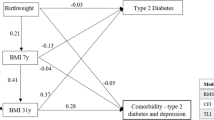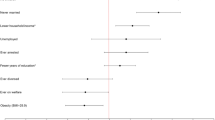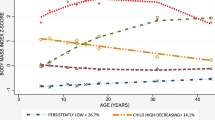Abstract
Objective:
Obesity and major depressive disorder (MDD) are associated, but evidence about how they relate over time is conflicting. The goal of this study was to examine prospective associations between depression and obesity from early adolescence through early adulthood.
Methods:
Participants were drawn from a statewide, community-based, Minnesota sample. MDD and obesity with onsets by early adolescence (by age 14), late adolescence (between 14 and 20) and early adulthood (ages 20–24) were assessed via structured interview (depression) and study-measured height and weight.
Results:
Cross-sectional results indicated that depression and obesity with onsets by early adolescence were concurrently associated, but the same was not true later in development. Prospective results indicated that depression by early adolescence predicted the onset of obesity (odds ratio (OR)=3.76, confidence interval =1.33–10.59) during late adolescence among female individuals. Obesity that developed during late adolescence predicted the onset of depression (OR=5.89, confidence interval=2.31–15.01) during early adulthood among female individuals.
Conclusions:
For girls, adolescence is a high-risk period for the development of this comorbidity, with the nature of the risk varying over the course of adolescence. Early adolescent-onset depression is associated with elevated risk of later onset obesity, and obesity, particularly in late adolescence, is associated with increased odds of later depression. Further investigation into the mechanisms of these effects and the reasons for the observed gender and developmental differences is needed. Prevention programs focused on early-onset cases of depression and adolescent-onset cases of obesity, particularly among female individuals, may help in reducing risk for this form of comorbidity.
This is a preview of subscription content, access via your institution
Access options
Subscribe to this journal
Receive 12 print issues and online access
$259.00 per year
only $21.58 per issue
Buy this article
- Purchase on Springer Link
- Instant access to full article PDF
Prices may be subject to local taxes which are calculated during checkout


Similar content being viewed by others
References
Faith MS, Butryn M, Wadden TA, Fabricatore A, Nguyen AM, Heymsfield SB . Evidence for prospective associations among depression and obesity in population-based studies. Obes Rev 2011; 12: e438–e453.
Simon GE, von Korff M, Saunders K, Miglioretti DL, Crane PK, van Belle G et al. Association between obesity and psychiatric disorders in the US adult population. Arch Gen Psychiatry 2006; 63: 824–830.
Atlantis E, Baker M . Obesity effects on depression: systematic review of epidemiological studies. Int J Obes 2008; 32: 881–191.
Daniel J, Honey W, Landen M, Marshall-Williams S, Chapman D, Lando J . Mental health in the united states: Health risk behaviors and conditions among persons with depression—New Mexico. CDC: MMWR Weekly 2003; 54: 989–991.
Ma J, Xiao L . Obesity and depression in US women: Results from the 2005-2006 National Health and Nutrition Examination Survey. Obesity 2010; 18: 347–353.
Ohayon MM . Epidemiology of depression and its treatment in the general population. J Psychiatric Res 2007; 41: 207–213.
Puhl RM, Brownell KD . Bias, discrimination, and obesity. Obes Res 2001; 9: 788–805.
Strauss RS . Childhood obesity and self-esteem. Pediatrics 2000; 105: e15.
Fontaine KR, Barofsky I . Obesity and health-related quality of life. Obes Rev 2001; 2: 173–182.
Gangwisch JE, Malaspina D, Boden-Albala B, Heymsfield SB . Inadequate sleep as a risk factor for obesity: analyses of the NHANES I. Sleep 2005; 28: 1289–1296.
Fava M, Judge R, Hoog SL, Nilsson ME, Koke SC . Fluoxetine versus sertraline and paroxetine in major depressive disorder: changes in weight with long-term treatment. J Clin Psychiatry 2000; 61: 863–867.
Bornstein SR, Schuppenies A, Wong ML, Licinio J . Approaching the shared biology of obesity and depression: the stress axis as the locus of gene-environment interations. Mol Psychiatry 2006; 11: 892–902.
Liu X, Buysse DJ, Gentzler AL, Kiss E, Mayer L, Kapornai K et al. Insomnia and hypersomnia associated with depressive phenomenology and comorbidity in childhood depression. Sleep 2007; 30: 83–90.
Kaufman J, Martin A, King RA, Charney D . Are child-, adolescent-, and adult-onset depression one and the same disorder? Bio Psychiatry 2001; 49: 980–1001.
Richardson LP, Davis R, Poulton R, McCauley E, Moffitt TE, Caspi A et al. A longitudinal evaluation of adolescent depression and adult obesity. Arch Ped Adoles Med 2003; 157: 739–745.
Holdcraft LC, Iacono WG . Cross-generational effects on gender differences in psychoactive drug abuse and dependence. Drug Alc Depend 2004; 74: 147–158.
Iacono WG, Carlson SR, Taylor J, Elkins IJ, McGue M . Behavioral disinhibition and the development of substance-use disorders: findings from the Minnesota Twin Family Study. Psychol Med 31: 411–423.
Reich W, Welner Z . The Diagnostic Interview for Children and Adolescents-Revised-Child/Parent Forms. Unpublished documents, Washington University. St Louis, MO, USA, 1988.
Spitzer RL, Williams JBW, Gibbon M . Structured Clinical Interview for DSM-III-R (SCID). New York State Psychiatric Institute, Biometrics Research: New York, NY, USA, 1987.
Baillargeon RH, Boulerice B, Tremblay RE, Zoccolillo M, Vitaro F, Kohen DE . Modeling interinformant agreement in the absence of a ‘‘gold standard’’. J Child Psychol Psychiatry 2001; 42: 463–473.
Burt SA, Krueger RF, McGue M, Iacono WG . Sources of covariation among attention-deficit/hyperactivity disorder, oppositional defiant disorder, and conduct disorder: the importance of shared environment. J Abnorm Psychol 2001; 101: 516–525.
Cantwell DP, Lewinsohn PM, Rohde P, Seeley JR . Correspondence between adolescent report and parent report of psychiatric diagnostic data. J Am Acad Child Adolesc Psychiatry 1997; 36: 610–619.
Spitzer RL, Endicott J, Robins E . Research diagnostic criteria: rationale and reliability. Arch Gen Psychiatry 1978; 35: 772–782.
Center for Disease Control 2000, http://www.cdc.gov/growthcharts/2000growthchart-us.pdf (accessed 16 February 2014).
Kuczmarski RJ, Ogden CL, Guo SS, Grummer-Strawn LM, Flegal KM, Mei Z et al. CDC growth charts for the United States: methods and development. Vital Health Stat 2002; 11: 1–190
Liang KY, Zeger SL . Longitudinal data analysis using generalized linear models. Biometrika 1986; 79: 13–22.
Falkner NH, French SA, Jeffrey RW, Neumark-Sztainer D, Sherwood NE, Morton N . Mistreatment due to weight: Prevalence and sources of perceived mistreatment in women and men. Obes Res 1999; 7: 572–576.
Tiggemann M, Rothblum ED . Gender differences in social consequences of perceived overweight in the United States and Australia. Sex Roles 1988; 18: 75–86.
Ingledew DK, Hardy L, Cooper CL, Jemal H . Health behaviours reported as coping strategies: a factor analytical study. Br J Health Psychol 1996; 1: 263–281.
Palinkas LA, Wingard DL, Barrett-Connor E . Depressive symptoms in overweight and obese older adults: a test of the ‘jolly fat’ hypothesis. J Psychosom Res 1996; 40: 59–66.
Franko DL, Striegel-Moore RH, Thompson D, Schreiber GB, Daniels S R . Does adolescent depression predict obesity in black and white young adult women? Psychol Med 2005; 35: 1505–1513.
Atlantis E, Goldney RD, Wittert GA . Obesity and depression or anxiety: clinicians should be aware that the association can occur in both directions. BMJ 2009; 339: b3868.
Acknowledgements
This research was supported by the following grants from the National Institutes of Health: DA022456, DA05147 and AA09367.
Author information
Authors and Affiliations
Corresponding author
Ethics declarations
Competing interests
The authors declare no conflicts of interest.
Rights and permissions
About this article
Cite this article
Marmorstein, N., Iacono, W. & Legrand, L. Obesity and depression in adolescence and beyond: reciprocal risks. Int J Obes 38, 906–911 (2014). https://doi.org/10.1038/ijo.2014.19
Received:
Revised:
Accepted:
Published:
Issue Date:
DOI: https://doi.org/10.1038/ijo.2014.19
Keywords
This article is cited by
-
The role of lifestyle and non-modifiable risk factors in the development of metabolic disturbances from childhood to adolescence
International Journal of Obesity (2020)
-
Is there any association between age at menarche and anthropometric indices? A 15-year follow-up population-based cohort study
European Journal of Pediatrics (2020)
-
Health-Related Quality of Life 5 Years After Roux-en-Y Gastric Bypass in Young (18–25 Years) Versus Older (≥ 26 Years) Adults: a Scandinavian Obesity Surgery Registry Study
Obesity Surgery (2019)
-
Obesity in Adolescents with Psychiatric Disorders
Current Psychiatry Reports (2019)
-
Depressive Symptoms During Adolescence Predict Adulthood Obesity Among Black Females
Journal of Racial and Ethnic Health Disparities (2018)



